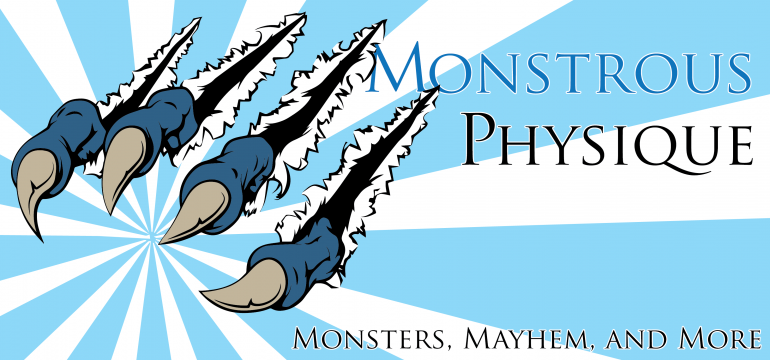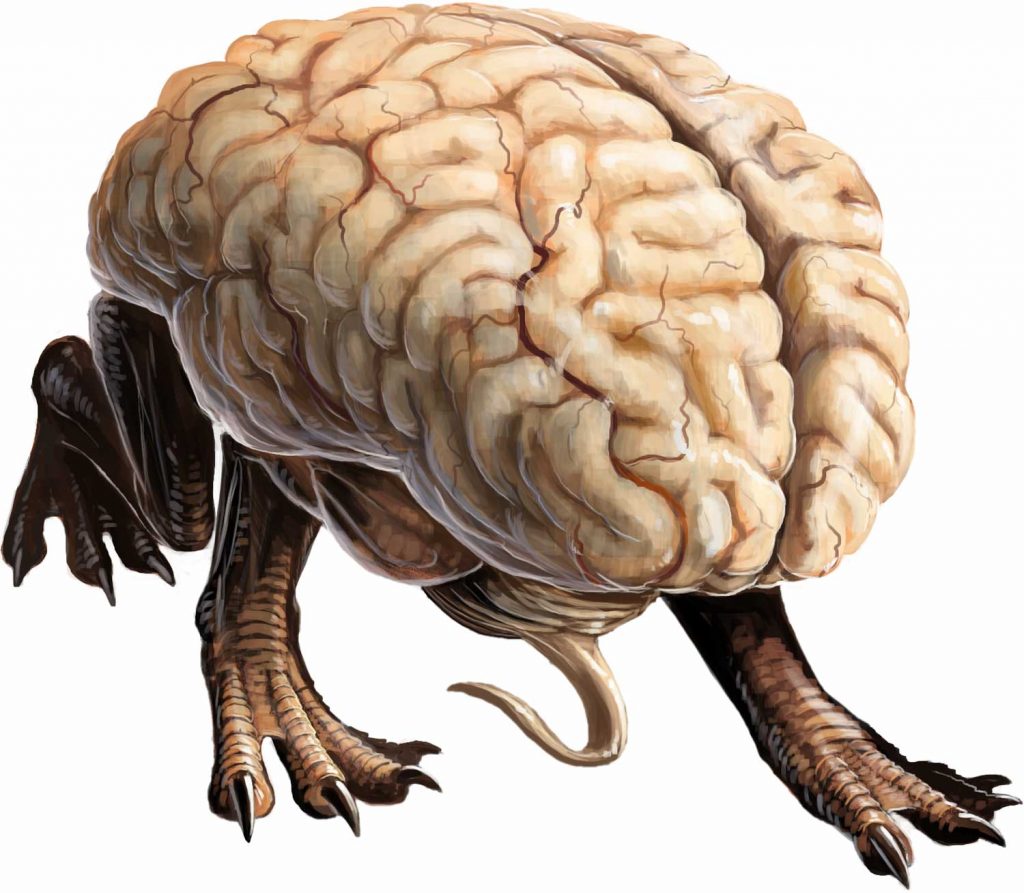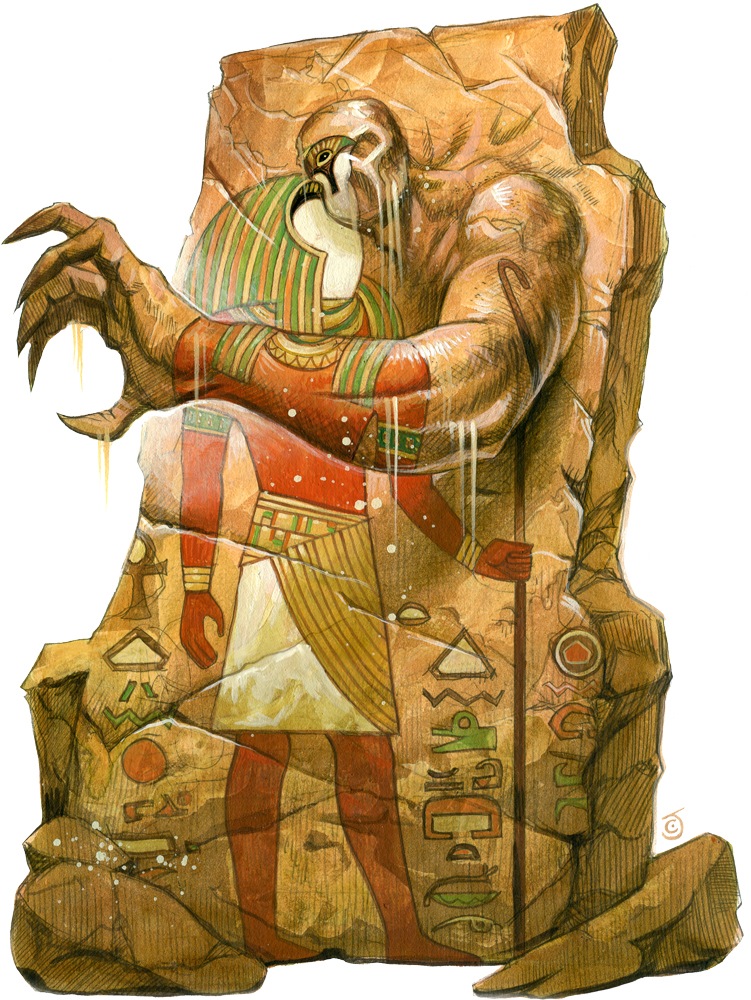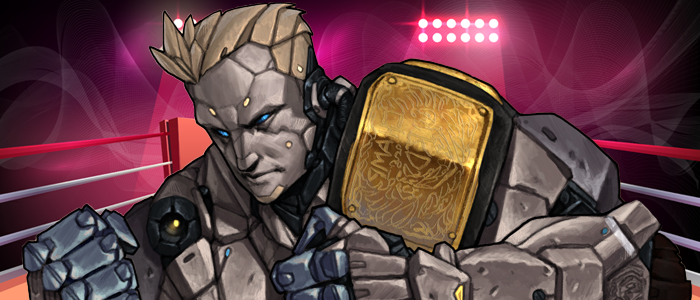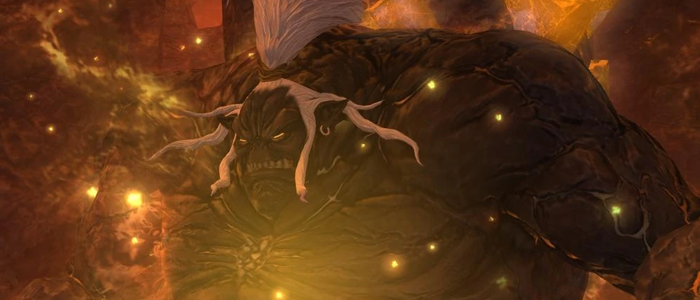At last we come to the end. Kasama is just about ready to be called complete. All we have left are the fine details. Again, this blog will feature very little crunch to work out, so I’m also going to give some more Monstrous Physique Secrets™ to help you on the way to your very own monsters. Let’s take our final dive!
Kasama is too big for her britches at this point. Rather than reproduce her stats, I’ll just again link you to the previous post. She’s looking pretty good, right? I’d say so. There are just a few tiny things left we have to get worked out, though. First, her CMD is missing some information. Any creature that has more legs than two receives bonuses to CMD in regards to trip attempts. Every extra leg grants her a +2 bonus, resulting in a CMD of 77 versus trip. Bonuses to CMB and CMD are common, usually stemming from Improved Combat Maneuver feats or special abilities like grab. Keep an eye on them to make sure you have the correct value for a given maneuver.
There are few more things I didn’t get to discuss. Let’s start with spell resistance. A lot of monsters have it and it’s important to know how it’s determined. While technically any creature can have SR, such as the CR 1 iron cobra, it is more common for creatures of CR 7 and higher. Outsiders, specifically angels, demons, and other allied outsiders, generally always have SR of some kind. The rule of thumb is to give SR equal to 11+CR for your creature. If you’re giving SR to low CR creature, try to shoot for 6+CR, instead. Rare exceptions, like the intellect devourer, have an amount equal to 15+CR. As there is no hard rule on when a creature gets SR, there’s a few things to consider before granting: Does it seem like the kind of creature that would be resistant to magic and are there other creatures of similar CR that also have spell resistance? How might SR affect the monster’s allies when trying to help the monster? Would having SR cause players frustration?
Another entry that I’ve avoided so far is the Ecology section. This is where you can detail where your creature lives and how much treasure it has. Locations can be whatever make sense for you. You will generally choose a biome and a climate, such as temperate forests. For treasure, I tend to stick with standard unless there’s some reason that your creature would have a differing amount of treasure available. Check out the introduction for the Bestiary for some more info on this. Finally, you can create the organization information for your creature. This is something I get a lot of enjoyment from because it lets me come up with cool names for creature groupings, like a grievance of balekin or a conclave of coautl. Have fun with this, but don’t feel that this entry is necessary. Unless you’re writing for publication, this entry is easily dropped. In fact, some people prefer to not deal with ecology at all!
There’s one last thing that we need to get figured out: Kasama’s flavor. This is one of the best parts of making your own monster. A lot of the time, for me at least, I’ll actually have the semblance of the flavor and backstory in mind while creating the monster. I feel it definitely helps guide the mechanical side of things. When it comes to creating the flavor for your creatures, I think there are a few things to focus on. First, what is the monster’s purpose? It can be a terrible, bestial undead that hates all living things or a crazy spider-deer that feeds on the threads of fate. Second, what does the monster look like? This covers the descriptive text at the beginning of the stat block as well as finer details like information on the creature’s physiology and height and weight. Finally, what are the creature’s social habits? It could be a tribal creature with an entire culture or it might be more solitary or even the last of its kind. These are all the main points that are hit upon by the description, ecology, and habitat & society sections of a monster in an Adventure Path bestiary.
Well, that’s it. Once you have all of these pieces in place, you should have a working monster. Obviously, not every monster is a large involved process like this. Kasama is CR 30 and has a lot of moving parts. The method you use to create your monsters will not always have to be as structured as this blog series implies. Whenever I’m making monsters, I find myself tweaking ability scores or feats and skills all of the time, hopping between different parts of the stat block until I get things just right. In fact, I had to constrain myself from my usual process to try to provide a more structured approach for you! Make your own monsters and you’ll start getting a feel for how things flow best for the way you work. Before I let you go, I want to reiterate a few things and give a few more tips.
Table 1–1 is your friend. Shoot for the numbers listed, but know you can stray a bit and still be okay.
- Publish ability scores are always 3 odd and 3 even numbers.
- A lot of your numbers can be made up! Natural armor, damage dice, and ability scores are all flexible, so use them to line up your results with Table 1–1.
- In a similar vein, feats like Improved Natural Armor and Improved Natural Attack are pointless when you can make the numbers whatever you want. Tweak scores and other numbers to get where you need!
- Steal Borrow as much as you can! Lots of monsters are already written and there is bound to be one with similar abilities that you want to use for your own. Copy those over and tweak them as necessary.
- Similarly, the Universal Monster Rules cover a lot of different abilities. Scope them out for something you might want.
- Monsters are short-lived. Try not to overload them with unique abilities that will never see the light of day. The safe bet is that your monster will survive 3 or 4 rounds maximum so work with that in mind.
- Try to keep things simple. A complicated ability is inevitable, but shoot for simple mechanics as often as you can. It will save you and other GMs time at the table.
- Sometimes, you can get away with just reskinning a monster rather than making one from scratch. If an owlbear has all the numbers you want, just reskin it. Call it a ravenous wanderer and describe it differently. Your players will never know the difference.
- Additionally, you can achieve a similar effect by adding a template to an already existing creature. A celestial or fiendish creature can already make a monster more interesting and there are plenty of other templates that can do so much more! I highly recommend the Advanced Bestiary for dozens of awesome templates.
- If this monster is not being published, don’t sweat the fine details. For your home game, you may never need to know your creature’s exact Sense Motive score. Pathfinder Unchained’s monster creation rules are great for this.
- Have fun with it! This doesn’t have to be work. It may take a few tries to get your sea legs, but once you have a feel of things, I hope it comes easily. I wouldn’t want to push you to do something you don’t like.

